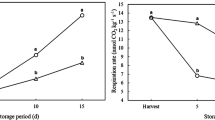Abstract
Effects of exogenous application of ascorbic acid on physiological and metabolic changes in tea were investigated in the present study. The highest improvement in yield was evident in response to regular application (a day after every harvest) of ascorbic acid at 600 ppm followed by 400 ppm. Foliar application of ascorbic acid (600 ppm) at regular intervals enhanced chlorophyll a and b contents besides a significant increase in total polyphenols and catechins when compared to the untreated control. Exogenous application of ascorbic acid at alternate harvesting rounds increased the activity of polyphenol oxidase whereas ascorbate peroxidase remained unchanged. An increase in phenylalanine ammonia lyase activity was noticed with foliar application of ascorbic acid irrespective of its concentrations. Theaflavins and thearubigins of made tea showed an increase when ascorbic acid was applied with 400 and 600 ppm at alternate intervals. The scores of brewed tea liquor characteristics, viz. infusion, color, strength, and briskness were higher even at the lower concentration of ascorbic acid treatment. Results suggest that foliar application of ascorbic acid (400 ppm) proved to be a useful measure to improve the yield, physiological attributes, and antioxidant properties of tea.
Similar content being viewed by others
References
Ameer Khan, Ahmad MSA, Athar HR, Ashraf M. 2006. Interactive effect of foliarly applied ascorbic acid and salt stress on wheat (Triticum aestivum L.) at the seedling stage. Pak. J. Bot. 38: 1407–1414
Arrigoni O, Calabrese G, De Gara L, Bitonti MB, Liso R. 1997. Correlation between changes in ascorbate and growth of Lupinus albus seedlings. J. Plant Physiol. 150: 302–338
Bassuony FM, Hassanein RA, Baraka DM, Khalil RR. 2008. Physiological effects of nicotinamide and ascorbic acid on Zea mays plant grown under salinity stress II-Changes in nitrogen constituents, protein profiles, protease enzymes and certain inorganic cations. Aust. J. Basic Appl. Sci. 2: 350–359
Beltagi MS. 2008. Exogenous ascorbic acid (vitamin C) induced anabolic changes for salt tolerance in chick pea (Cicer arietinum L.) plants. Afr. J. Plant Sci. 2: 118–123
Bradford MM. 1976. A rapid and sensitive method for the quantification of microgram quantities of protein utilizing the principle of protein-dye binding. Anal. Biochem. 72: 248–254
Dev-Choudhury MN, Goswami MR. 1983. A rapid method for determination of total polyphenolic matters in tea (Camellia sinensis L.). Two Bud 30: 59–61
El-Tohamy WA, El-Abagy HM, El-Greadly NHM. 2008. Studies on the effect of putrescine, yeast and vitamin C on growth, yield and physiological response of eggplant (Solanum melongena L.) under sandy soil conditions. Aust. J. Basic Appl. Sci. 2: 296–300
Farahat MM, Ibrahim MMS, Taha SL, El-Quesni EMF. 2007. Response of vegetative growth and some chemical constituents of Cupressus sempervirens L. to foliar application of ascorbic acid and zinc at Nubaria. World J. Agri. Sci. 3: 496–502
Garg OK, Singh, BP. 1971. Physiological significance of ascorbic acid in relation to drought resistance in rice (Oryza sativa L.). Plant Soil 34: 219–223
Harsh PS, Ravindranath. 1994. Occurrence and distribution of PPO activity floral organs of some standard and local cultivars of tea. J. Sci. Food Agri. 64: 117–120
Hemanta KP, Mishra D. 1979. Pyrophosphatase, peroxidase and polyphenoloxidase activities during leaf development and senescence. Plant Physiol. 63: 318–323
Miyake C, Asada K. 1992. Thylakoid bound ascorbate peroxidase in spinach chloroplast and photoreduction of its primary oxidation product, monodehydroascorbate radicals in the thylakoids. Plant Cell Physiol. 33: 541–553
Muraleedharan N, Hudson JB, Durairaj J. 2007. Guidelines on tea culture in south India. 8th Edn, Coonoor Printing Press, Coonoor, Tamil Nadu
Noctor G, Foyer CH. 1998. Ascorbate and glutathione: keeping active oxygen under control. Ann. Rev. Plant Physiol. Mol. Bio. 49: 249–279
Raj Kumar R, Jibu T. 2004. Physiological basis of cultivar char acterization in tea (Camellia spp.). J. Plantation Crops 32(suppl.): 54–57
Raj Kumar R, Marimuthu S, Jeyakumar D, Jeyaramraja PR. 2002. In situ estimation of leaf chlorophyll and its relation ship with photosynthesis in tea. Ind. J. Plant Physiol. 7: 367–371
Reda F, Abdel-Rahim EA, El-Baroty GSA, Ayad HS. 2005. Response of essential oils, phenolic components and polyphenol oxidase activity of thyme (Thymus vulgaris L.) to some bioregulators and vitamins. Int. J. Agri. Bio. 7: 735–739
Reda F, Gamal El-Din KM. 2005. Effect of thiamine and ascorbic acid treatment on growth, flowering and some biochemi cal constituents of chamomile (Chamomilla recutita L. Rausch). Egypt. J. Appl. Sci. 18: 191–205
Sadasivam S, Manikam A. 1996. Estimation of total free amino acids. In Biochemical Methods, 2nd Edn. New Age International Publishers and Tamil Nadu Agricultural University, Coimbatore, Tamil Nadu
Shalata A, Neumann PM. 2001. Exogenous ascorbic acid (vitamin C) increase resistance to salt tolerance and reduced lipid peroxidation. J. Exp. Bot. 364: 2207–2211
Smirnoff N. 1996. The function and metabolism of ascorbic acid in plants. Ann. Bot. 78: 611–669
Suzuki Y, Ogiso K. 1973. Development of ascorbate oxidase activity and its isozyme pattern in the roots of pea seedlings. Physiol. Plant. 29: 169–172
Swain T, Hillis WE. 1959. The phenolic constituents of Prunus domesticatus L. the quantitative analysis of phenolic constituents. J. Sci. Food Agri. 10: 63–68
Thanaraj SNS, Seshadari R. 1990. Influence of polyphenol oxidase activity and polyphenol content of tea shoot on quality of black tea. J. Sci. Food Agri. 35: 57–69
Xu F, Chang J, Cheng SY, Zhu J, Li LL, Wang Y, Cheng H. 2009. Promotive effect of 5-aminolevulinic acid on the antioxidant system in Ginkgo biloba leaves. Afr. J. Biotech. 8: 3769–3776
Author information
Authors and Affiliations
Corresponding author
Rights and permissions
About this article
Cite this article
Murugan, A.C., Thomas, J., Rajagopal, R.K. et al. Metabolic responses of tea (Camellia sp.) to exogenous application of ascorbic acid. J. Crop Sci. Biotechnol. 15, 53–57 (2012). https://doi.org/10.1007/s12892-011-0047-x
Received:
Revised:
Accepted:
Published:
Issue Date:
DOI: https://doi.org/10.1007/s12892-011-0047-x




